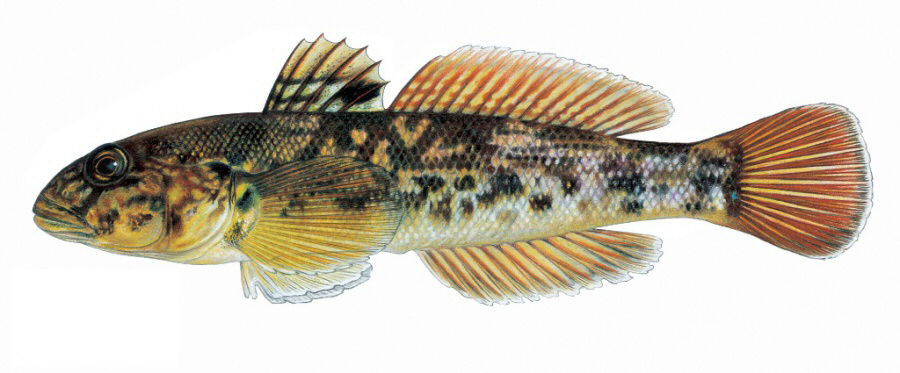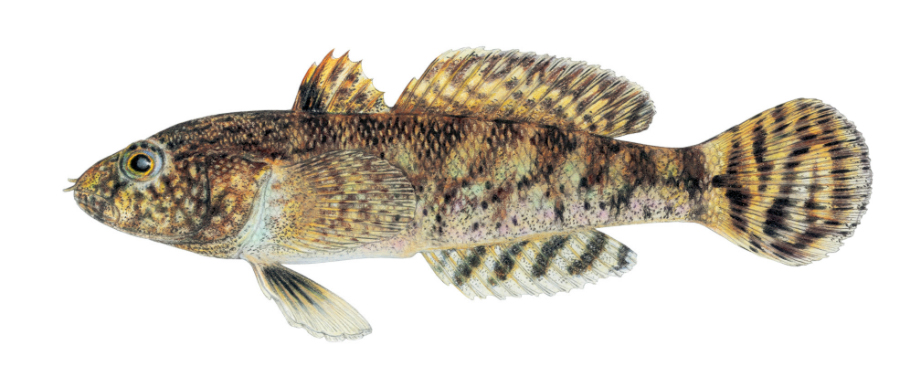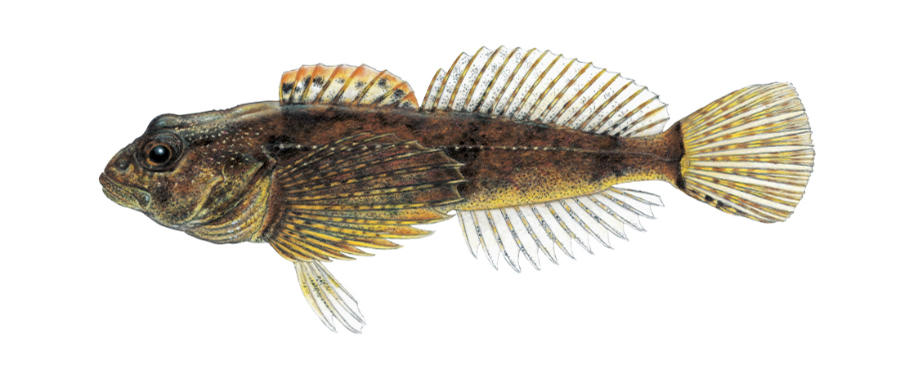Background
The Round Goby is a small, bottom-dwelling invasive fish, native to the Black and Caspian seas in eastern Europe. It was first found in North America in 1990, in the St. Clair River north of Windsor, Ontario. Researchers believe the fish was brought to North America in the ballast water of ships from Europe. In less than a decade, the Round Goby has successfully spread through all five Great Lakes and has begun to invade inland waters. In some areas, the fish has reached densities of more than 100 fish per square metre of lake bottom nearshore. Round Goby prefers waters with rocky and sandy bottoms. They feed aggressively on insects and other small organisms found on lake and river bottoms. Adult Round Goby eat large quantities of zebra mussels, small fish, and fish eggs. Their aggressive eating habits, and their ability to spawn several times each season, have helped them spread quickly over a large area.
Range
Outside of its native range, the Round Goby has been found in all five Great Lakes and many of their tributaries, including the Illinois River. Round Goby are also found in some inland waters in southern Ontario, such as Lake Simcoe, Lake Couchiching, the Trent River, Rice Lake, and parts of the Otonabee River.
For an up to date distribution map of Round Goby in Ontario, visit www.EDDMapS.org/distribution.
Impacts of Round Goby
The Round Goby’s aggressive habits and rapid spread have had serious impacts on native species, including:
- Round Goby compete with, and prey on, native bottom-dwelling fish, such as Mottled Sculpin (Cottus bairdii) and Logperch (Percina caprodes). Round Goby also threatens several species at risk in the Great Lakes Basin, including the Northern Madtom (Noturus stigmosus), the Eastern Sand Darter (Ammocrypta pellucida), and several species of freshwater mussels.
- Round Goby have reduced populations of sport fish by eating their eggs, their young, and competing for food sources.
- Researchers believe the Round Goby is linked to outbreaks of botulism type-E in Great Lakes’ fish and fish-eating birds. The disease is caused by a toxin that is passed from zebra mussels to goby, to birds, resulting in large die-offs of fish and birds.
To prevent the spread of this invasive species, the Ontario government has banned the possession of live Round Goby and the use of Round Goby as baitfish.
How to Identify Round Goby
Adult Round Goby are 6 – 16 cm (2.4 – 6.3 in) long, with a cylindrical body, and a rounded to blunt snout. The Round Goby looks similar to several species of fish found in the Great Lakes, including the invasive Tubenose Goby (Proterorhinus semilunaris) and native sculpins (Myoxocephalus thompsoni and Cottus sp.). Check the chart below to identify Round Goby, Tubenose Goby, and native sculpins.
INVASIVE
Round Goby
(Neogobius melanostomus)
Details
- Prominent black spot on first dorsal fin.
- Fused scallop-shaped pelvic fin.
- Body is brownish or olive in colour, with dark brown spots. Except in reproducing males, the body and fins are almost completely black.
- Nostril tubes do not reach the upper lip.
- Fully scaled body.
INVASIVE
Tubenose Goby
(Proterorhinus semilunaris)
Details
- No black spot.
- Fused scallop-shaped fin.
- Body is grey, light brown, olive or tan with black or reddish-brown mottling on the back.
- Small nostril tubes extend over the upper lip.
- Fully scaled body
What You Can Do
- Learn how to identify Round Goby and how to prevent the spread of this unwanted species.
- Never buy or use Round Goby as bait. It is against the law to use Round Goby as bait or to have this species in your possession.
- Don’t put any live fish into Ontario lakes, rivers, or streams.
- If you have any information about the illegal importation, distribution, or sale of Round Goby, report it immediately to the MNRF at 1-877-847-7667, toll-free any time. You can also call Crime Stoppers anonymously at 1-800-222-TIPS (8477).
- If you’ve seen a Round Goby or another invasive species in the wild, please contact the toll-free Invading Species Hotline at 1-800-563-7711, visit EDDMapS, or search for the ‘Invasive Species in Ontario’ project on iNaturalist.org to report a sighting.
Gallery
OFAH/OMNRF Invading Species Awareness Program. (2021). Round Goby. Retrieved from: www.invadingspecies.com.
This factsheet may be reproduced for non-commercial purposes.
Header photo by Ontario Federation of Anglers and Hunters | Fish illustrations © Joe Tomelleri.





